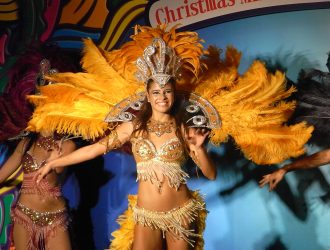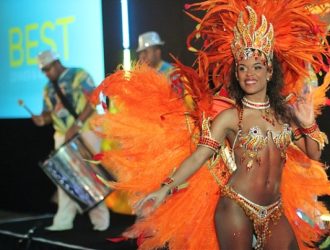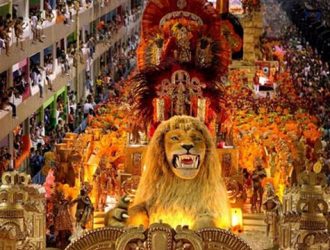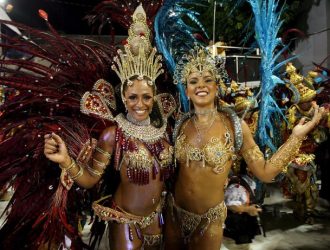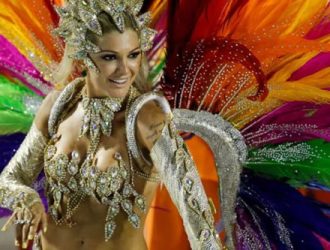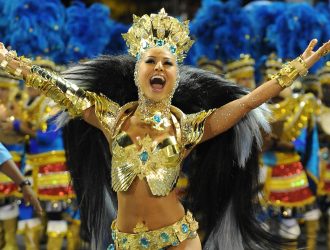Brazilian Samba
The Brazilian Samba is a lively, rhythmical dance of Afro-Brazilian origin that originated from a dance known as the Maxixe.
Overview#
Samba is a dance authentic to Black/African people in Brazil who brought much of their music and dance culture into Latin America with them upon arrival into many Latin American countries. Samba music is very similar to many Angolan music genres. Angola is a country on the western coast of southern Africa. Angolan music not only influenced Samba music, but many other Latin American music genres and dances as well. The Samba music rhythm has been danced in Brazil since its inception in the late 16th century.
There is actually a set of dances, rather than a single dance, that define the Samba dancing scene in Brazil; thus, no one dance can be claimed with certainty as the “original” Samba style.
Another major stream of the Samba dance, besides the Brazilian Samba, is the Ballroom Samba, which differs significantly from its origin. This style is danced with a partner in closed or open hold positions, including but not limited to hand to hand hold, or side by side positions.
History#
Samba, an old Brazilian style of dance with many variations, is African in origin. It has been performed as a street dance at carnival, the pre-Lenten celebration, for almost 100 years. Many versions of the Samba (from Baion to Marcha) are danced at the local carnival in Rio. The Ballroom Samba or Carioca Samba is derived from the rural “Rocking Samba” and has been known for many years. (The Carioca is a small river that runs through Rio de Janiero – hence the name Carioca refers to the people of Rio.) Today, Samba is still very popular in Rio. During carnival time, there are “schools of Samba” involving thousands of elaborately-costumed dancers presenting a national theme based on music typical of Brazil and Rio in particular.
Before 1914, the Samba was known under a Brazilian name “Maxixe“. As early as 1923, an international meeting of professors of dancing took note of the rise of the Samba’s popularity, particularly in France. A French dance book published by Paul Boucher in 1928 included Samba instructions. The dance was introduced to the United States movie audiences in 1933 when Fred Astaire and Dolores Del Rio danced the Carioca in Flying Down to Rio and several years later, Carmen Miranda danced the Samba in That Night in Rio. A Samba exhibition was given at the November 1938 meeting of the New York Society of Teachers of Dancing. General interest in the Samba was stimulated at the 1939 World’s Fair in New York, where Samba music was played at the Brazilian Pavilion. A few years later, the Brazilian composer Ary Barroso wrote the classic Samba, “Brasil,” which quickly became a hit, and in 1944 he went to Hollywood to write the score for the musical Brazil. Samba has a very specific rhythm, highlighted to its best by characteristic Brazilian musical instruments: originally called tamborim, chocalho, reco-reco and cabaca. Much of Samba music came from daily life in Rio, the first famous example being “Pelo Telefone” composed by Donga. To achieve the true character of the Samba, a dancer must give it a happy, flirtatious and exuberant interpretation. Many figures, used in the Samba today, require a pelvic tilt (Samba tic) action. This action is difficult to accomplish, but without it, the dance loses much of its effect. Principal characteristics of the Samba are the rapid steps taken on a quarter of a beat and the pronounced rocking motion and sway of the dancing couple. The Samba (also known as the Brazilian Waltz) is now a moderately popular Ballroom Dance, limited pretty much to experienced Ballroom dancers because of its speed.
Styles of Samba#
Samba no pé#
Samba no pé is a solo dance that is most often danced impromptu when Samba music is played. The basic movement involves a straight body and a bending of one knee at a time. The feet move very slightly – only a few inches at a time. The rhythm is 2/4, with 3 steps per measure. It can be thought of as a step-ball-change. It can be described by calling it and-a-one, and-a-two, then back to one. The basic movement is the same to either side, where one foot moves to the outside lifting up just before the first beat (i.e. the right leg moves slightly to the right) and leg is kept as straight as a pole. The other foot moves slightly towards the front, and closer to the first foot. The second leg bends lightly at the knee so that the left side of the hip lowers and the right side appears to move higher. The weight is shifted to this inside foot briefly for the next “and-a”, then shifted back to the outside foot on the “two”, and the same series of actions is repeated towards the other side.
The dance simply follows the beat of the music and can go from average pace to very fast. Men dance with the whole foot on the ground while women, often wearing heels, dance just on the balls of the foot. Professionals may change the steps slightly, taking 4 steps per measure instead of 3, and often add various arm movements depending on the mood of the music.
There are also regional forms of the dance in Brazil where the essential steps are the same, but because of a change in the accent of the music, people will dance similar movements to the slightly changed accents. For instance, in Bahia, the girls tend to dance tilting their legs towards the outside instead of keeping their knees close to each other as in Rio de Janeiro.
This is the type of Samba one sees in the Brazilian Carnival parades and in other Samba carnivals over the world. This is also one of the most popular Sambas.
Samba de Gafieira#
Samba de Gafieira is a partner dance considerably different from the Ballroom Samba. It appeared in the 1940’s and it gets its name from the gafieira, the popular urban nightclubs of Rio de Janeiro at that time.
The dance derived from the Maxixe and followed the arrival of the Choro (another Samba musical style). It left most of the Maxixe’s Polka elements behind but maintained the entwined leg movements of the Argentine Tango, although adopting a more relaxed posture than the latter. Many see this form of Samba as a combination of Waltz and Tango. Several Brazilian dance studios use elements and techniques from these two dances to teach Samba de Gafieira steps and dance routines.
Samba Axé#
Samba Axé is a solo dance that started in 1992 during the Brazilian Carnival season in Bahia when the Axé rhythm replaced the Lambada. For years it became the major type of dance for the Northeast of Brazil during the holiday months. The dance is completely choreographed and the movements tend to mimic the lyrics. It’s a very energetic kind of dance that mixes elements of Samba no pé and aerobics. Because of the lyrics, which are made for entertainment, the dance generally has some sort of ludic and spontaneous element.
Several Axé music groups such as “É o Tchan” have as part of their marketing strategy to always release a choreography together with every one of their songs; therefore, Samba Axé is an ever-changing kind of dance with no commitment to maintaining any formal set of steps or routines (there’s actually no such a thing as a basic step in Samba Axé.)
Samba Reggae#
Also originating from Bahia, Samba Reggae is a mix of Reggae beats with Samba drums. Samba Reggae is very popular in songs by Daniela Mercury, who catapulted this rhythm to the world with songs like “Sol da Liberdade,” “O Reggae E O Mar,” and “Perola Negra”. Samba Reggae is the second most popular Samba style in Bahia, with followers all over Brazil.
Samba-Rock#
Samba Rock is a playful form of the Samba, and it originates in São Paulo. It is a Latin nightclub dance.
